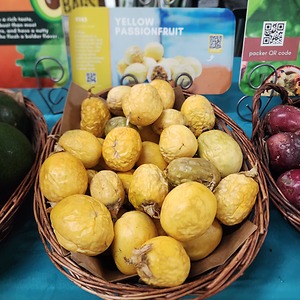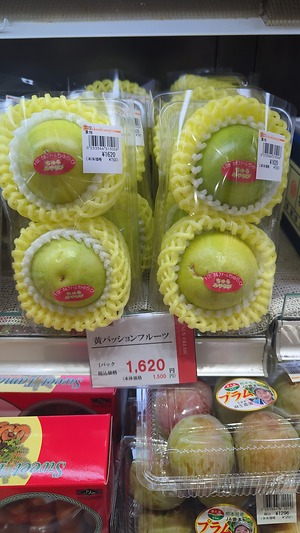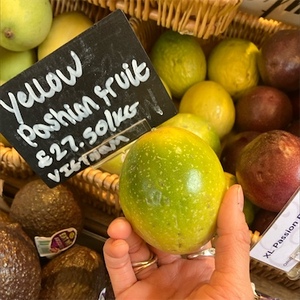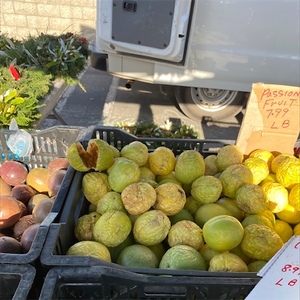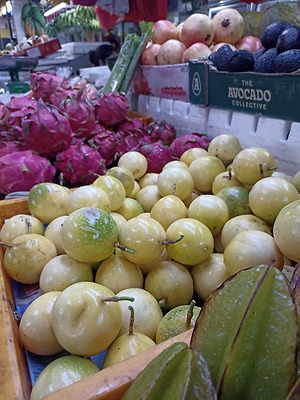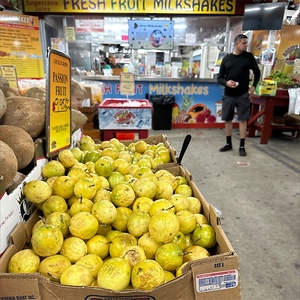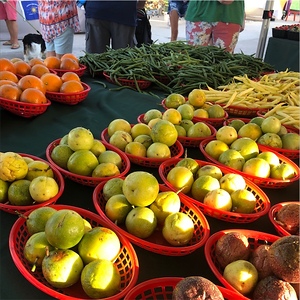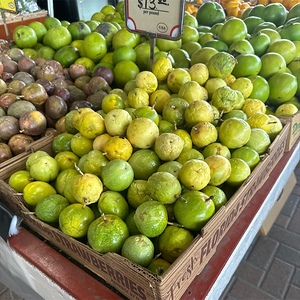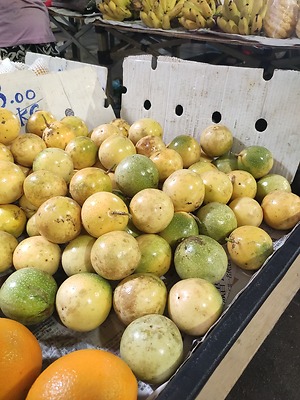The Yellow passionfruit has a round to egg like shape and thick yellow skin, oftentimes tinged with spots of lime green. The interior of its rind has soft creamy white walls and encases an exceptionally juicy yellow-orange pulp and many petite brown seeds. Its flavor is sweet, acidic and tropical with mild floral notes. Growing on a climbing vine the Yellow passionfruit has green tendrils and leaves and will bloom prior to fruiting. The ornate and colorful flowers of the Yellow passionfruit are larger more aromatic than the Purple variety.
Yellow passionfruit is available in the late winter and throughout the summer months.
Yellow passionfruit, botanically known as P. edulis f. flavicarpa is a perennial vine and a member of the Passifloraceae or Passion Flower family. There are close to 500 varieties of passion flower grown today, along with the Purple passionfruit the Yellow passionfruit is one of the only types of passionfruit commercially grown. The Yellow passionfruit when grown in ideal conditions will yield more fruit than the Purple variety.
Yellow passionfruit contains riboflavin and niacin and is rich in amino acids. They also are higher in citric acid and carotene than the Purple passionfruit though they have a lower content of ascorbic acid.
Yellow passionfruits are sought after for the gelatinous, sweet-tart pulp they contain on their interior. The pulp can be used raw or cooked in both sweet and savory preparations. The pulp with seeds can be used as is in fruit salads, cocktails or served a top yogurt and ice cream. Seeds can be removed or consumed along with the pulp. To remove the seeds strain the pulp through cheesecloth or a fine mesh strainer. The seed free pulp of the Yellow passionfruit can be boiled down and used to make jams, sauces, beverages, ice cream, sweet syrups, savory sauces, pie filings, quick breads and cakes. To cut the tart acidity of the pulp when eating fresh add a little cream and sugar to the pulp.
In Hawaii the Yellow passionfruit is known as Lilikoi and used as a flavoring for syrups and shaved ice. In Venezuela they are known as Parcha Amarilla and are commonly used to make ice cream, preserves and a popular bottled passionfruit, rum cocktail. The name passion was given by Spanish missionaries who saw the flowers and plant as a visual representation of the Passion of the Christ. The curled tendrils as the whips, the three anthers and five stamens as the nails and wounds, the ten sepals and petals as the ten apostles and the radial filaments at the center as the crown of thorns. The Yellow passionfruit is also utilized by chemists to produce a fragrant compound known as Oxane which is used to impart a tropical scent in products.
The traditional Purple passionfruit originated in the Amazon region of Brazil, Yellow passionfruit as well is thought to have possibly originated there as a hybrid of P. edulis (Purple passionfruit) and P. ligularis (Sweet Granadilla) or potentially as a chance mutant in Australia. A tropical fruit, the Yellow passionfruit thrives in areas that receive adequate rainfall and sunshine. Its vines do well if sheltered from the wind and will be less susceptible to pests if allowed to grow climbing up a tree or trellis. Today it is grown commercially predominately in Australia, New Zealand, Hawaii, India, Columbia, Brazil and Venezuela.
Recipes that include Yellow Passionfruit. One
Yellow Passionfruit
08/23/2024
View Notes
Abriendo Caminos Farm
The Yellow passionfruit grows on a climbing vine with green tendrils and leaves, producing ornate, colorful flowers that bloom before the fruit appears. These flowers are notable for being larger and more aromatic compared to the Purple variety. This combination of vibrant blossoms and juicy fruit makes the Yellow passionfruit a stunning addition to gardens and farms alike.
Yellow Passionfruit
06/06/2024
View Notes
Yellow passionfruits offer versatility beyond their raw use with seeds intact. Their pulp, once strained to remove seeds, can be boiled down and transformed into jams, sauces, sweet syrups, savory sauces, pie fillings, quick breads, and cakes. To curb their tart acidity for fresh consumption, a touch of cream and sugar enhances their flavor, making them even more enjoyable.
Yellow Passionfruit
03/11/2024
View Notes
Yellow passionfruit is a perennial vine from the Passifloraceae family, scientifically named P. edulis f. flavicarpa. Alongside the Purple variety, it is one of the few passionfruits commercially grown. When grown in optimal conditions, Yellow passionfruit yields more fruit than the Purple kind. It contains riboflavin, niacin, and amino acids. Additionally, it has higher levels of citric acid and carotene but less ascorbic acid compared to its Purple counterpart.
Yellow Passionfruit
12/08/2023
View Notes
Rancho Santa Cecilia
The Yellow passionfruit, a tropical hybrid, is believed to have originated in Brazil, potentially as a natural hybrid of Purple passionfruit and Sweet Granadilla, or as a chance mutant in Australia. This fruit thrives in warm, sunny climates with adequate rainfall and is less prone to pests when grown on a tree or trellis. It is now cultivated commercially in locations such as Australia, New Zealand, Hawaii, India, Colombia, Brazil, and Venezuela.
Yellow Passionfruit
11/20/2023
View Notes
Yellow Passionfruit: In Hawaii, the Yellow passionfruit is called Lilikoi and adds tropical flavor to syrups or shaved ice, while in Venezuela, it’s named Parcha Amarilla and used in ice cream, preserves, or a rum-based cocktail. Beyond its culinary uses, chemists extract a fragrant compound, Oxane, from the fruit. This compound is used to infuse tropical scents into various products, enhancing aromatic experiences.
Yellow Passionfruit
07/13/2023
View Notes
Robert Is Here
19200 SW 344th St Homestead FL 33034
+1 (305) 246-1592
Yellow passionfruit: Its pulp is versatile and can be enjoyed raw or cooked in both sweet and savory dishes. You can integrate it into fruit salads, cocktails, or use it as a topping for yogurt and ice cream. For seed-free applications like jams, sauces, or pie fillings, strain the pulp through a fine mesh. To balance its tartness when eaten fresh, add cream and sugar for a smoother, sweeter taste.
Yellow Passionfruit
02/02/2023
View Notes
Truman Waterfront Market
Weech Way Key West Fl 33040
+1 (305) 731-3385
Yellow passionfruit has a round shape and thick yellow skin, occasionally tinged with lime-green spots. Inside, its creamy white rind walls encase juicy yellow-orange pulp filled with petite brown seeds. The flavor combines tropical sweetness, acidity, and mild floral notes. It grows on climbing vines that display green leaves and tendrils, with ornate, aromatic flowers larger than those of the Purple passionfruit variety.
Yellow Passionfruit
02/02/2023
View Notes
Robert Is Here
19200 SW 344th st. Homestead, FL 33034
305-246-1592
Yellow passionfruit is a perennial vine from the Passifloraceae family, one of nearly 500 passion flower varieties grown today. Alongside the Purple passionfruit, it's among the few commercially cultivated types. In optimal conditions, the Yellow variety outproduces the Purple. Nutritionally, it boasts riboflavin, niacin, amino acids, and higher levels of citric acid and carotene, while containing less ascorbic acid compared to its Purple counterpart.
Yellow Passionfruit
12/10/2022
View Notes
Yellow passionfruit: In Hawaii, Yellow passionfruit is called Lilikoi, famed for flavoring syrups and shaved ice. Venezuelans know it as Parcha Amarilla and use it in ice cream, preserves, and passionfruit rum cocktails. Spanish missionaries linked its flower's structures to symbols of the Passion of Christ, seeing curled tendrils as whips, anthers and stamens as nails and wounds, and radial filaments as the crown of thorns. Its compound, Oxane, adds tropical fragrance to products.
Yellow Passionfruit
08/13/2022
View Notes
Robert is Here Fruit Stand
19200 SW 344th Street, Homestead, FL 33034
305-246-1592
Yellow passionfruit thrives in tropical regions with ample rainfall and sunlight. Its vines grow best when sheltered from wind and are less prone to pests if supported by a tree or trellis. This variety likely originated from either a hybrid of Purple passionfruit and Sweet Granadilla or a natural mutation in Australia. Today, it's cultivated commercially in Australia, New Zealand, Hawaii, India, Colombia, Brazil, and Venezuela.
View Full Share Market®






